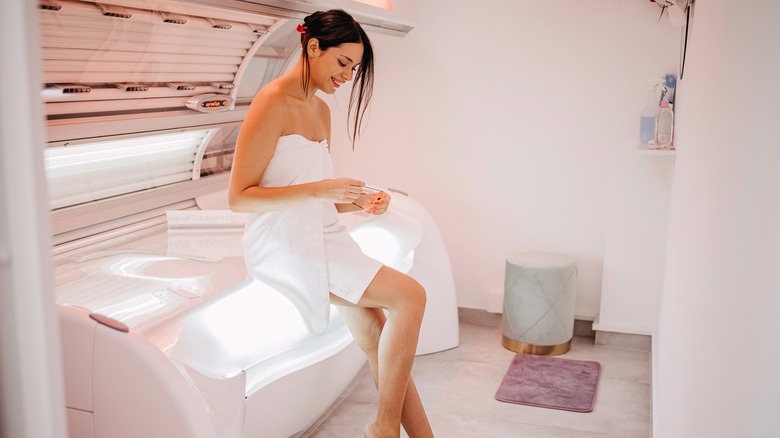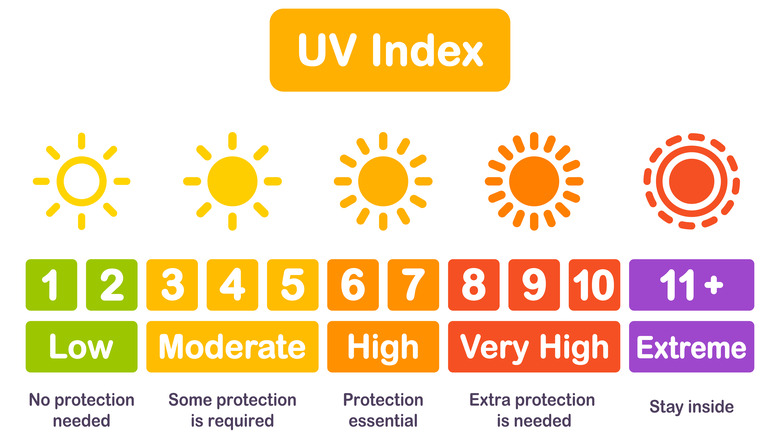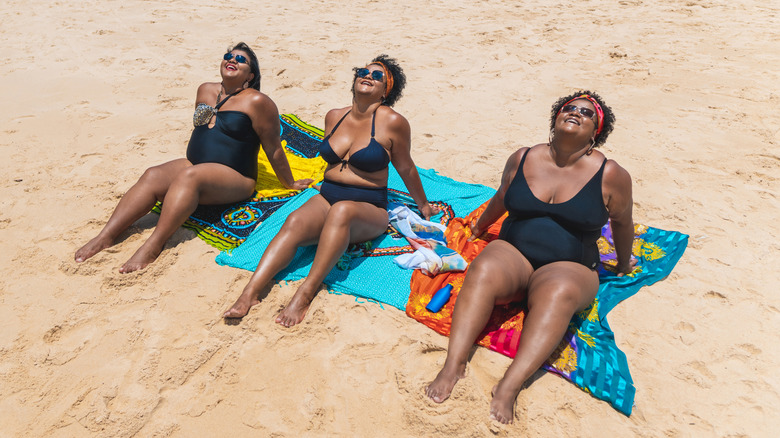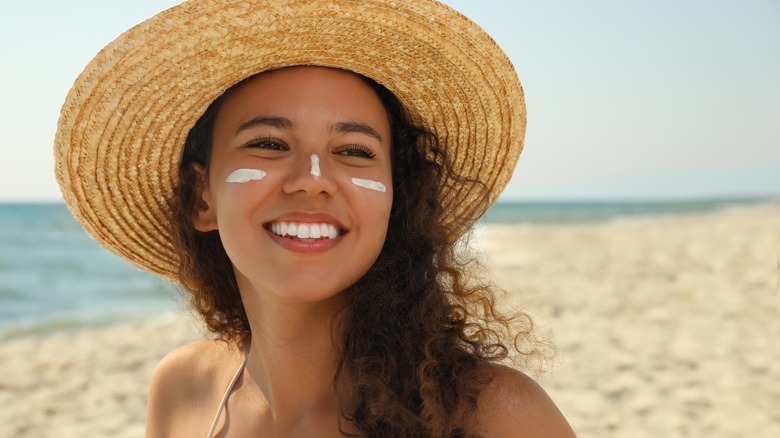Does A Lower UV Index Make For A Safer Tan? Here Are The Facts
Summer sun may have you grasping for your golden opportunity for the equally golden sun-kissed skin of a summer tan. Before you rush outside, getting answers and knowing facts about how to protect your skin from ultraviolet (UV) radiation, plus clarifying confusion over how and when to take measures to protect your skin, are essential elements for informed decisions about your skin's lifelong well-being.
While mitigating the risk of sun damage to the skin and taking necessary steps to reduce chances of developing life-threatening skin cancers is no laughing matter, it can still be extremely tempting to want to lounge poolside during the hottest times of the year and enjoy soaking up vitamin D while your skin gets the tan you've been itching for all year. To achieve bronzed skin with minimal UV radiation exposure, UV index tanning has become a trend. The premise of the practice is to utilize the UV index, an international rating system, to determine the current UV intensity, and tan during times with purportedly optimal amounts of UV ray exposure.
Before diving into UV index tanning, know that although UV radiation can intensify during summer months, it remains consistently present throughout the year regardless of weather, temperature, or other factors. You can still go after that glow you've wanted all year, but the facts about UV radiation exposure are definitely warning signs to protect your skin.
Busting myths about UV rays
The sun emits various ultraviolet radiation wavelengths, with two types reaching the earth's surface and our bodies. Those are ultraviolet A (UVA) and ultraviolet B (UVB), per Skin Cancer Foundation. Both UVA and UVB rays penetrate our skin and cause radiation damage. Longer UVA wavelengths cause deeper, long-term skin damage like wrinkles and hyperpigmentation, while shorter UVB wavelengths are common culprits of sunburns. The fact of the matter is that whenever the sun is out, so are UV rays.
UVA and UVB rays reach the earth's surface disproportionately. UVA rays form 95% of ultraviolet radiation posing a risk to our bodies, and they are considered more dangerous than UVB rays since UVA rays target tissue beneath the skin's upper layers, causing wrinkles, hyperpigmentation, and heightening the risk of skin cancers like melanoma and basal cell carcinoma. Whenever you're near an indoor window, a shocking reality is that your skin risks UVA damage, as UVA rays pass through glass. Busting two common myths, UVA rays can harm skin even if the sun isn't visible, and UVA rays, in particular, maintain their strength of skin damaging radiation year-round regardless of the seasons.
Though only 5% of total UV radiation exposure, UVB rays are known to cause damage to the DNA within the skin's layers, states American Cancer Society. Both types of ultraviolet rays are attributed to skin cancers, making UV protection essential for long-term dermal health. Tanning beds utilize UVA and UVB rays for achieving results, thus constituting dangerous exposure to skin, reveals Harvard Medical School.
Understanding the ultraviolet (UV) index
The UV index (UVI) is a measurement of ultraviolet radiation strength at any given time, and the higher the rate rises, the more likely dangerous exposure is to occur and the less time it takes for skin to become damaged, according to the World Health Organization (WHO). If the UVI rating is higher, critical exposure risking damage to both skin and eyes is more likely. The UVI is a highly monitored rating system that was created in collaboration with numerous international organizations, including the United Nations, which created the rating system to alert communities and individuals about how strong ultraviolet radiation is in their area at any time. The UV index is constantly evaluated and its efficacy is maintained by stringent international protocols, so it's considered a reliable source of information about ultraviolet radiation intensity in your region. However, just because the UVI is reliable and strictly monitored, that doesn't negate the damage caused by UV rays nor condone overlooking skin protection measures like sunscreen application at any given time because of a lower local UV index rating.
The UV index is available for desktop download or mobile app through the United States Environmental Protection Agency (EPA). If you love having fun in the sun and yearn for sun-kissed skin, this is your sign to download the EPA-maintained United States UV index ASAP!
The truth about UV index tanning
The idea of UV index tanning is that, by monitoring the strength of ultraviolet radiation exposure in your area through the UV index, you'll be able to tan safely during times when your local UVI is at a desirable rate (via Beautymone). It's purported that the magic UVI rating for a golden glow is between four and five, though note that UV index tanning is not a regulated activity and no oversight of safe UVI ratings for tanning is conducted by the EPA or any other entity. The UV index is intended to let users know how vital it is for them to protect their skin from sun exposure, it's not meant to advise optimal UVI strengths for tanning. Tanning is generally not recommended as safe for skin, though if you choose to tan at a lower UVI rating for your area, you should always wear sunscreen regardless of a low UVI reading. All sunscreen and SPF products should have values of at least 30, which you should reapply every two hours regardless of weather, UVI rating, or any other factors. You will live in your skin for your entire life, so prioritize its protection with the utmost care.
Now the discussion returns to artificial tanning methods, like tanning beds and indoor tanning lights. Insider reports that indoor tanning beds can expose skin to UVI strengths of 12 and higher. Quite simply, indoor tanning and artificial methods utilizing UV rays are extremely dangerous.
The risks of UV index tanning and how to protect skin
In a 'yes' or 'no' sense, the answer to whether or not UV index tanning is safe would be that no, it's not. The more complicated answer is that UV index tanning is theoretically safer because attention is being paid to the amount of ultraviolet radiation exposure, and that awareness is a sign that mindfulness and consideration are being given to skin protection, at least to some degree. If you decide to try UV index tanning, again know that it isn't approved, regulated, monitored, or promoted by any health or research-backed organization. It's entirely up to the judgment of the people using the UV index to assess when to tan. But a better way to use the UV index once you've downloaded it from the EPA is to get to know when UV radiation is strongest in your local area and how you can best protect your skin throughout the day with the newfound information you're gathering.
Radiation from sunlight affects our bodies in ways we may not even realize, like causing damage to our eyes when UV index ratings are at high levels. Cleveland Clinic advises wearing sunglasses with UV broad spectrum protection, plus sun protective clothing with UPF values. Alongside daily sunscreen of SPF 30 minimum, you can use respective protective measures accordingly, and particularly when you know UV radiation is strongest because you have the UVI as a key resource.




